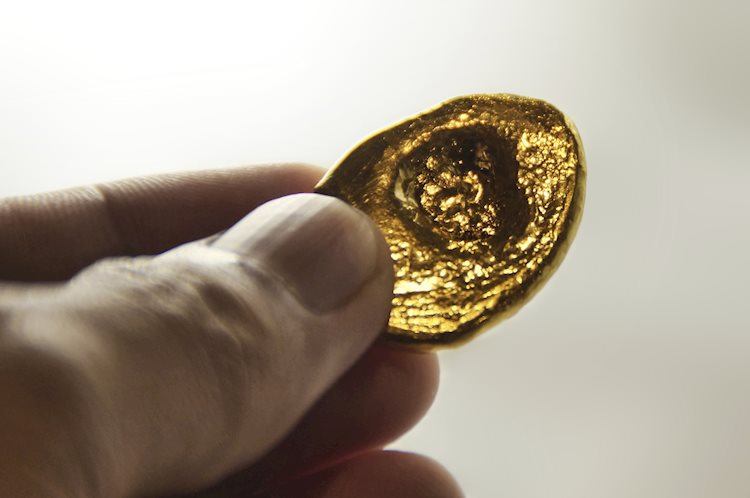- Gold price drifts lower and reverses a part of Thursday’s softer US CPI-inspired positive move.
- An uptick in the US bond yields revives the USD demand and exerts pressure on the XAU/USD.
- Rising September Fed rate cut bets should act as a tailwind for the metal and help limit losses.
Gold price (XAU/USD) gained strong positive traction on Thursday and rallied to the $2,424-2,425 region, or its highest level since May 22 after another tame US inflation report lifted bets that the Federal Reserve (Fed) will cut rates in September. The commodity, however, lacks follow-through buying amid a modest US Dollar (USD) rebound from a nearly three-month low, bolstered by a goodish pickup in the US Treasury bond yields. This, along with the underlying bullish sentiment surrounding the equity markets, prompts some selling around the safe-haven precious metal during the European session on Friday.
Gold price, for now, seems to have snapped a three-day winning streak, though any meaningful corrective downfall still seems elusive in the wake of expectations that the Fed will start its rate-cutting cycle sooner rather than later. Apart from this, political uncertainty in the US and Europe, along with geopolitical risks and concerns about a global economic slowdown, should act as a tailwind for the XAU/USD, warranting caution for bears. Traders now look to the release of the US Producer Price Index (PPI) and the University of Michigan Consumer Sentiment survey for a fresh impetus later during the North American session.
Daily Digest Market Movers: Gold price drifts lower amid rebounding US bond yields, modest USD strength
- Gold price surged past the $2,400 mark on Thursday following the release of the softer-than-expected US consumer inflation figures, which lifted bets for a September interest rate cut by the Federal Reserve.
- The US Bureau of Labor Statistics (BLS) reported that the headline Consumer Price Index (CPI) dipped in June for the first time in more than four years and the yearly rate decelerated to 3% from 3.3% in May.
- Meanwhile, the core CPI, which excludes volatile food and energy prices, was up 0.1% during the reported month and rose 3.3% YoY, also missing consensus estimates and the 3.4% increase registered in May.
- Investors were quick to react and are now pricing in over a 90% chance that the Fed will lower borrowing costs at the September monetary policy meeting, as indicated by the CME Group’s FedWatch Tool.
- Furthermore, the December 2024 fed funds rate futures contract implies that the US central bank will cut policy rates by 49 basis points (bps) toward the end of the year, up from 39 bps a day ago.
- San Francisco Fed President Mary Daly acknowledged improving inflation figures and said that the economy looks to be on a path where one or two rate cuts this year would be more or less appropriate.
- Separately, St. Louis Fed President Alberto Musalem noted that recession risks remain low, and the disinflation process is ongoing, though policymakers would like to see more progress.
- Meanwhile, the yield on the benchmark 10-year US government bond tumbled to its lowest level since March, dragging the US Dollar to a three-month trough and providing a strong boost to the yellow metal.
- This overshadowed the better-than-expected release of the US Initial Jobless Claims, which fell to 222K for the week ending July 6 as compared to expectations for a reading of 236K and the 239K previous.
- The XAU/USD, however, struggles to capitalize on the overnight strong move up amid a modest USD uptick during the Asian session on Friday, though the fundamental backdrop favors bullish traders.
Technical Analysis: Gold price bulls have the upper hand, $2,390-2,388 should protect any further downfall
From a technical perspective, the overnight sustained breakout through the $2,400 mark was seen as a fresh trigger for bullish traders. Moreover, oscillators on the daily chart have been gaining positive traction and are still away from being in the overbought territory. This further validates the near-term positive outlook for the Gold price, suggesting that any meaningful slide might be seen as a buying opportunity and remain limited.
Some follow-through selling below the $2.388-2.387 horizontal resistance breakpoint, now turned support, could drag the XAU/USD towards the $2,358 region with some intermediate support near the $2,372-2,371 area. On the flip side, the overnight swing high, around the $2,425 region now seems to act as an immediate hurdle, above which the Gold price is more likely to aim back towards challenging the all-time peak, around the $2,450 region touched in May.
US Dollar price today
The table below shows the percentage change of US Dollar (USD) against listed major currencies today. US Dollar was the strongest against the Japanese Yen.
| USD | EUR | GBP | CAD | AUD | JPY | NZD | CHF | |
| USD | 0.03% | 0.08% | -0.03% | 0.01% | 0.57% | -0.10% | -0.03% | |
| EUR | -0.03% | 0.04% | -0.06% | 0.01% | 0.48% | -0.13% | -0.07% | |
| GBP | -0.09% | -0.04% | -0.11% | -0.03% | 0.44% | -0.17% | -0.11% | |
| CAD | 0.03% | 0.06% | 0.10% | 0.08% | 0.55% | -0.06% | -0.01% | |
| AUD | -0.01% | -0.02% | 0.02% | -0.08% | 0.46% | -0.14% | -0.09% | |
| JPY | -0.58% | -0.56% | -0.46% | -0.58% | -0.51% | -0.62% | -0.54% | |
| NZD | 0.08% | 0.12% | 0.17% | 0.06% | 0.14% | 0.60% | 0.06% | |
| CHF | 0.01% | 0.05% | 0.09% | -0.01% | 0.07% | 0.52% | -0.07% |
The heat map shows percentage changes of major currencies against each other. The base currency is picked from the left column, while the quote currency is picked from the top row. For example, if you pick the Euro from the left column and move along the horizontal line to the Japanese Yen, the percentage change displayed in the box will represent EUR (base)/JPY (quote).
Gold FAQs
Gold has played a key role in human’s history as it has been widely used as a store of value and medium of exchange. Currently, apart from its shine and usage for jewelry, the precious metal is widely seen as a safe-haven asset, meaning that it is considered a good investment during turbulent times. Gold is also widely seen as a hedge against inflation and against depreciating currencies as it doesn’t rely on any specific issuer or government.
Central banks are the biggest Gold holders. In their aim to support their currencies in turbulent times, central banks tend to diversify their reserves and buy Gold to improve the perceived strength of the economy and the currency. High Gold reserves can be a source of trust for a country’s solvency. Central banks added 1,136 tonnes of Gold worth around $70 billion to their reserves in 2022, according to data from the World Gold Council. This is the highest yearly purchase since records began. Central banks from emerging economies such as China, India and Turkey are quickly increasing their Gold reserves.
Gold has an inverse correlation with the US Dollar and US Treasuries, which are both major reserve and safe-haven assets. When the Dollar depreciates, Gold tends to rise, enabling investors and central banks to diversify their assets in turbulent times. Gold is also inversely correlated with risk assets. A rally in the stock market tends to weaken Gold price, while sell-offs in riskier markets tend to favor the precious metal.
The price can move due to a wide range of factors. Geopolitical instability or fears of a deep recession can quickly make Gold price escalate due to its safe-haven status. As a yield-less asset, Gold tends to rise with lower interest rates, while higher cost of money usually weighs down on the yellow metal. Still, most moves depend on how the US Dollar (USD) behaves as the asset is priced in dollars (XAU/USD). A strong Dollar tends to keep the price of Gold controlled, whereas a weaker Dollar is likely to push Gold prices up.
















